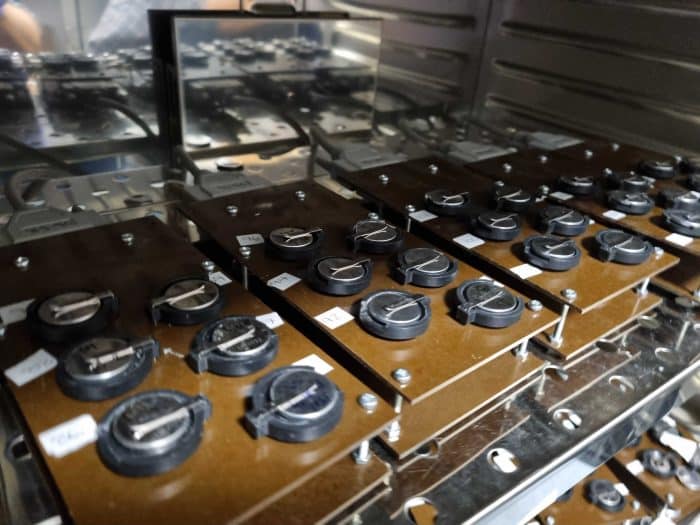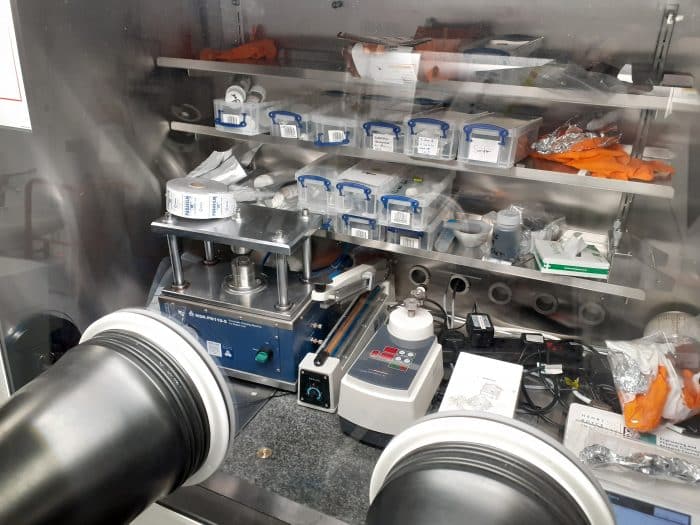Overview
Based in the Centre for Energy Materials Research (CEMR) at the University of Oxford, this technology platform is home to extensive capabilities for the handling and study of air-sensitive materials. The facility is designed to enable seamless transfer under continuous inert atmosphere from preparation stage through to a range of characterisation techniques, eliminating the risk of reaction with ambient moisture, CO2 or O2.
Air exposure can interfere with many materials properties and have a detrimental effect on their performance. This is particularly problematic in energy applications which often involve sensitive electrochemical processes, reactions at interfaces, and the handling of highly reactive compounds. For these reasons, energy materials research is frequently confined to gloveboxes. A key challenge with this approach is that in most cases gloveboxes are operated as isolated units and only offer space for a limited range of experiments without transfer.
In this Royce Technology Platform, uninterrupted handling and analysis of air-sensitive samples is achieved through three key strategies:
- Interconnecting gloveboxes with linking antechambers and an automated inert transfer trolley
- Locating benchtop equipment in gloveboxes and operating the instruments under inert atmosphere. Key capabilities include X-ray diffractometry (XRD), nuclear magnetic resonance (NMR), atomic force microscopy (AFM), physical vapour deposition (PVD) and others
- Using transfer suitcases which can be docked onto larger external instruments such as X-ray photoelectron spectrometers (XPS), electron microscopes (EM), and synchrotron beamlines; these can all be opened directly to vacuum
These inert handling facilities form part of a wider ecosystem of energy materials research within the CEMR at Oxford involving the academic research groups of several Department of Materials Principal Investigators, as well as active involvement of industrial partners through collaborative R&D programmes. A core focus of the centre’s research is on next-generation energy storage materials driven by the UK’s dedicated battery research institute, the Faraday Institution, but the full range of activity extends beyond batteries to electrocatalysis, hydrogen materials, and fuel cells.
The CEMR is equipped with an extensive range of electrode processing, multi-format cell assembly and electrochemical cycling equipment. Characterisation tools such as GC-MS and liquid-state NMR permit the study of electrolyte breakdown products, and the chemical composition of surface films can be investigated by XPS. Specialised cell designs enable operando investigations with techniques such as XRD, XPS and online electrochemical mass spectrometry (OEMS) as the electrochemical process unfolds.

Capability
The Inert Sample Preparation and Characterisation Technology Platform at the University of Oxford is home to unique capabilities for the handling and study of air sensitive energy materials. The facility is designed to enable seamless transfer under continuous inert atmosphere from preparation stage through to a range of characterisation techniques, eliminating the risk of contamination from ambient moisture, CO2 or O2 .
Inert Preperation
- Pouch cell and coin cell fabrication
- Electrode mixing, casting and calendaring
- Inert ceramic hot pressing & sintering
- Inert high energy ball-milling
- Sectioning with PFIB, nano-SIMS
- Inert electrochemical cell fabrication
- Inert Physical Vapour Deposition (PVD)
Bulk Characterisation
- Thermogravimetric Analysis (TGA-MS)
- Raman Spectrometer
- Dynamic Light Scattering (DLS)
- Analyser Inert Pico-indenter
- Nano-indenter
- Inert X-ray Diffraction (XRD)
Electrochemical Stability
- Electrochemical Impedance Spectroscopy (EIS)
- Environmental test chambers
- Inert temperature-controlled cycling chambers
- Electrochemical Testing Suite
- Inert Nuclear Magnetic Resonance (NMR)
- Gas-Chromatography Mass Spectrometry (GC-MS)
Surface Characterisation
- Atomic Force Microscope (AFM)
- X-ray Photoelectron Spectroscopy (XPS)





